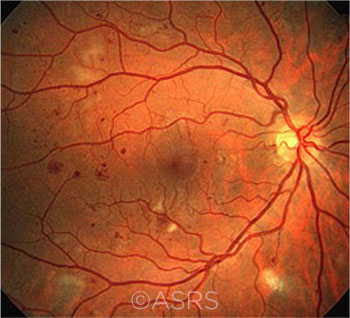Download PDF
Researchers at Wills Eye Hospital have added to their growing body of evidence that too many patients are lost to follow-up after receiving an anti-VEGF injection.
In their most recent study of nonadherence, one-fourth of patients with nonproliferative diabetic retinopathy (DR) and diabetic macular edema (DME) did not return for follow-up within 12 months after receiving an injection.1 Hispanics, lower income patients, and those with poorer baseline vision were among those most likely to be lost to follow-up.
 |
NONCOMPLIANCE. Approximately 1 in 4 patients with nonproliferative DR (shown here) and macular edema had no follow-up visit for at least a year postinjection. This image was originally published in the ASRS Retina Image Bank. Henry J. Kaplan, MD, and Niloofar Piri, MD. NPDR. Retina Image Bank. 2013; Image Number 5362. © The American Society of Retina Specialists.
|
Recalcitrant problem. This finding was consistent with the group’s previous studies of patients receiving anti-VEGF injections for wet AMD, retinal vein occlusion, and proliferative DR.2
“Almost across the board, with all diagnoses we have looked at, about a quarter of patients are lost to follow-up immediately after receiving an anti-VEGF injection,” said Jason Hsu, MD, at Wills Eye Hospital in Philadelphia. “Given the importance of ongoing therapy to prevent vision loss, these real-world findings are of significant concern.”
Parsing risk factors. In this retrospective cohort study, 1,632 patients received a total of 10,884 anti-VEGF injections over 15,803 clinical visits. Of these patients, 355 had no further visits for more than 12 months after the last injection.
The researchers also found the following:
- By self-identified racial group, 35% of Hispanic patients were lost to follow-up, followed by 30.6% of Asian patients, 29.1% of black patients, and 21.3% of white patients.
- Patients living in zip codes with lower-than-average adjusted gross income were more likely to miss the next appointment. For instance, 32.4% of those in a low-income zip code (defined as less than $50,000 per year) were lost to follow-up. In contrast, 18.4% of those in a higher-income zip code (defined as more than $75,000 per year) did not return for treatment.
- Decreasing baseline vision also was significantly associated with risk of nonadherence. In a subgroup of the 923 DME patients, the lowest rate of attrition (12.4%) was found in those with a baseline VA that was 20/50 or better; the highest rate of attrition (32.5%) occurred in those with a baseline VA of 20/80 or worse.
- The patient’s stage of nonproliferative DR did not significantly predict the risk of loss to follow-up or interact with other factors.
Clinical implications. Dr. Hsu urged physicians to track patients carefully. He also suggested making phone calls or sending letters to encourage patients to return for care. “I worry that many patients with preventable vision loss are losing their sight as a result of nonadherence with follow-up.” (See also this month’s Journal Highlights.)
—Miriam Karmel
___________________________
1 Gao X et al. Ophthalmol Retina. 2019;3(3):230-236.
2 Obeid A et al. Ophthalmology. Published online Aug. 2, 2018.
___________________________
Relevant financial disclosures—Dr. Hsu: Genentech/Roche: S.
For full disclosures and the disclosure key, see below.
Full Financial Disclosures
Dr. Asaoka Kowa: S; Oculus: S; Reichert Technologies: S.
Mr. Boyle None.
Dr. Hsu Genentech/Roche: S; Ophthotech: S; Santen: S.
Dr. Palanker DigiSight: C; Johnson & Johnson: C; Pixium Vision: C,P; Topcon Medical Systems: C,P.
Dr. Small None.
Disclosure Category
|
Code
|
Description
|
| Consultant/Advisor |
C |
Consultant fee, paid advisory boards, or fees for attending a meeting. |
| Employee |
E |
Employed by a commercial company. |
| Speakers bureau |
L |
Lecture fees or honoraria, travel fees or reimbursements when speaking at the invitation of a commercial company. |
| Equity owner |
O |
Equity ownership/stock options in publicly or privately traded firms, excluding mutual funds. |
| Patents/Royalty |
P |
Patents and/or royalties for intellectual property. |
| Grant support |
S |
Grant support or other financial support to the investigator from all sources, including research support from government agencies (e.g., NIH), foundations, device manufacturers, and/or pharmaceutical companies. |
|
More from this month’s News in Review